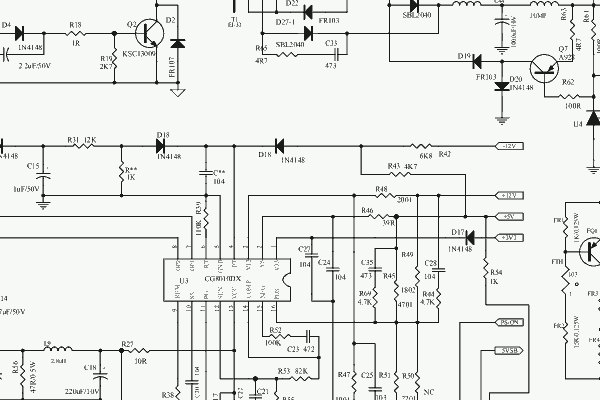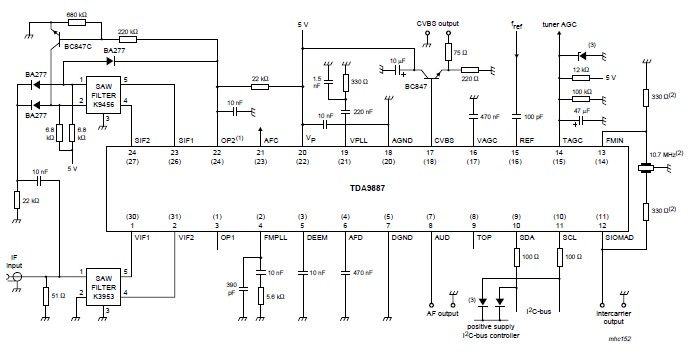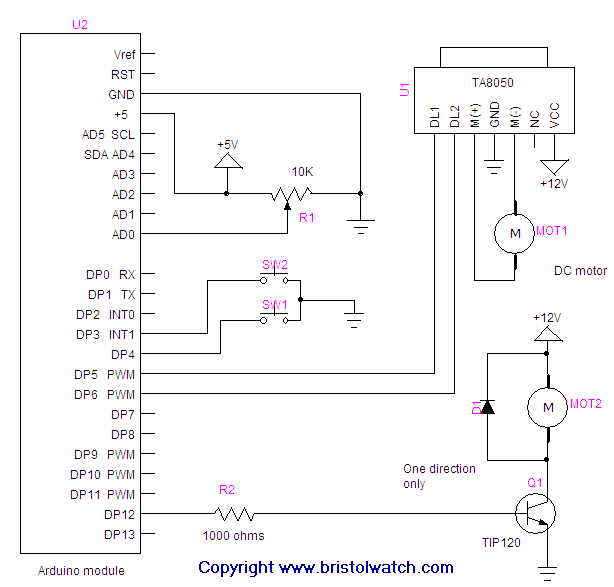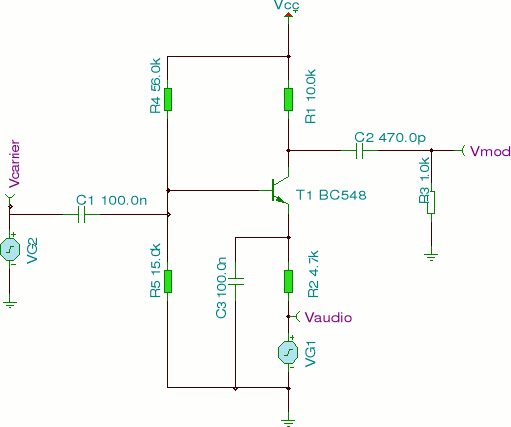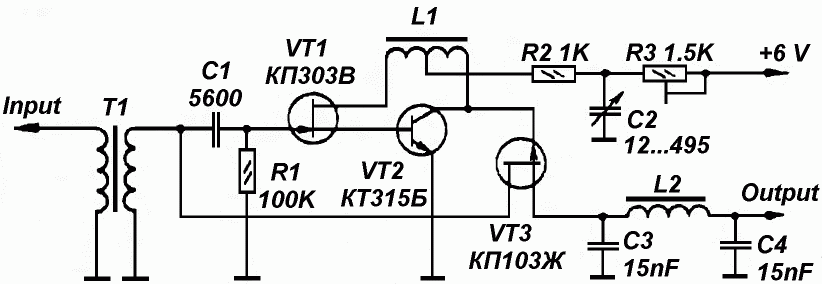
PWM Modulator
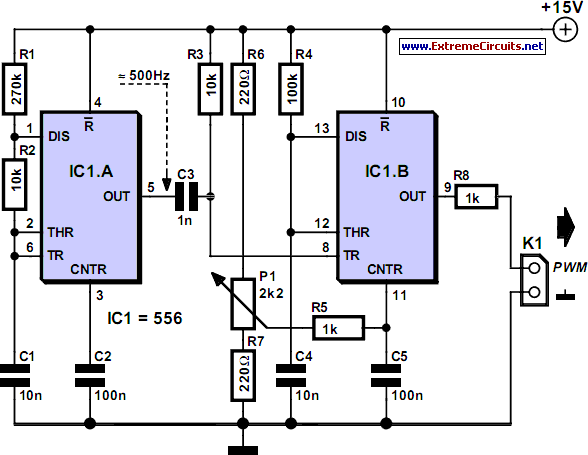
This circuit serves as an introduction to pulse-width modulation experimentation, utilizing a dual 555 timer for simplicity. A small PCB has been designed to facilitate construction. Although not an original design, it complements the "Dimmer with MOSFET" article on this website. The circuit operates at a frequency of 500 Hz, dividing each half-period of the dimmer into five sections to minimize interference. The first timer functions as a standard astable frequency generator, with its frequency defined by the formula 1.49 / (R1 + 2R2) × C1 [Hz]. R2 is kept small to allow easy frequency variation by adjusting R1 and/or C1. The second timer operates as a monostable multivibrator, triggered by a differentiator made up of R3 and C3, which responds to a rising edge. A low level at the trigger input results in a low output from the timer. R3 and C3 are included to maximize the control range. The pulse width of the monostable timer is determined by 1.1 × R4 × C4, resulting in a duration of just over one millisecond, approximately half the period of IC1a. The pulse width can be adjusted using P1, which alters the voltage at the CNTR input, affecting the internal comparators of the timer and varying the charging time for C4. The control range is influenced by the supply voltage, set at 15V. The voltage range for P1 is regulated by R6, R7, and R5, yielding a control voltage between 3.32V and 12.55V (the prototype's supply voltage was 14.8V). The output activates only when the voltage exceeds 3.51V, producing a duty cycle of 13.5%. This initial quiet range ensures that the lamp remains off. R8 protects the output from short circuits. When the opto-coupler of the dimmer is used as a load, the circuit's maximum current consumption is approximately 30mA.
The circuit employs a dual 555 timer configuration, which is a versatile approach for generating pulse-width modulation signals. The first timer is set up in astable mode, continuously oscillating and generating a square wave output. The frequency of oscillation can be adjusted by varying the resistors R1 and R2, along with the capacitor C1, allowing for fine-tuning of the output signal to match the desired application. The choice of a frequency of 500 Hz is strategic, as it minimizes electromagnetic interference, making it suitable for controlling lighting applications.
The second timer, configured as a monostable multivibrator, serves to modulate the width of the output pulse based on the input trigger from the differentiator circuit formed by R3 and C3. This setup ensures that the output pulse width can be varied by adjusting the potentiometer P1, which modifies the voltage at the CNTR input. This voltage adjustment impacts the timing of the internal comparators, thereby influencing how quickly the capacitor C4 charges, which directly correlates to the output pulse width.
The design incorporates a protection mechanism via resistor R8 to safeguard against potential short circuits, ensuring reliability during operation. Additionally, the circuit's current consumption remains low, approximately 30mA, making it efficient for various applications, including dimming lamps via an opto-coupler. The range of control voltages provided by the potentiometer and the limiting resistors allows for a smooth transition of the output signal, enhancing the dimming capabilities without abrupt changes in intensity. Overall, this circuit design exemplifies a practical and efficient approach to implementing pulse-width modulation using widely available components.If you ever thought of experimenting with pulse-width modulation, this circuit should get you started nicely. We`ve kept simplicity in mind and used a dual 555 timer, making the circuit a piece of cake. We have even designed a small PCB for this, so building it shouldn`t be a problem at all. This certainly isn`t an original circuit, and is here ma inly as an addition to the Dimmer with MOSFET` article elsewhere in this website. The design has therefore been tailored to this use. A frequency of 500 Hz was chosen, splitting each half-period of the dimmer into five (a low frequency generates less interference). The first timer is configured as a standard astable frequency generator. There is no need to explain its operation here, since this can easily be found on the Internet in the datasheet and application notes.
All we need to mention is that the frequency equals 1. 49 / (R1+2R2) G— C1) [Hz] R2 has been kept small so that the frequency can be varied easily by adjusting the values of R1 and/or C1. The second timer works as a monostable multivibrator and is triggered by the differentiator constructed using R3 and C3.
The trigger input reacts to a rising edge. A low level at the trigger input forces the output of the timer low. R3 and C3 have therefore been added, to make the control range as large as possible. The pulse-width of the monostable timer is given by 1. 1xR4xC4 and in this case equals just over a millisecond. This is roughly half the period of IC1a. The pulse-width is varied using P1 to change the voltage on the CNTR input. This changes the voltage to the internal comparators of the timer and hence varies the time required to charge up C4. The control range is also affected by the supply voltage; hence we`ve chosen 15V for this. The voltage range of P1 is limited by R6, R7 and R5. In this design the control voltage varies between 3. 32V and 12. 55V (the supply voltage of the prototype was 14. 8V). Only when the voltage reaches 3. 51 V does the output become active, with a duty-cycle of 13. 5 %. The advantage of this initial quiet` range is that the lamp will be off. R8 protects the output against short circuits. With the opto-coupler of the dimmer as load, the maximum current consumption of the circuit is about 30mA.
🔗 External reference
The circuit employs a dual 555 timer configuration, which is a versatile approach for generating pulse-width modulation signals. The first timer is set up in astable mode, continuously oscillating and generating a square wave output. The frequency of oscillation can be adjusted by varying the resistors R1 and R2, along with the capacitor C1, allowing for fine-tuning of the output signal to match the desired application. The choice of a frequency of 500 Hz is strategic, as it minimizes electromagnetic interference, making it suitable for controlling lighting applications.
The second timer, configured as a monostable multivibrator, serves to modulate the width of the output pulse based on the input trigger from the differentiator circuit formed by R3 and C3. This setup ensures that the output pulse width can be varied by adjusting the potentiometer P1, which modifies the voltage at the CNTR input. This voltage adjustment impacts the timing of the internal comparators, thereby influencing how quickly the capacitor C4 charges, which directly correlates to the output pulse width.
The design incorporates a protection mechanism via resistor R8 to safeguard against potential short circuits, ensuring reliability during operation. Additionally, the circuit's current consumption remains low, approximately 30mA, making it efficient for various applications, including dimming lamps via an opto-coupler. The range of control voltages provided by the potentiometer and the limiting resistors allows for a smooth transition of the output signal, enhancing the dimming capabilities without abrupt changes in intensity. Overall, this circuit design exemplifies a practical and efficient approach to implementing pulse-width modulation using widely available components.If you ever thought of experimenting with pulse-width modulation, this circuit should get you started nicely. We`ve kept simplicity in mind and used a dual 555 timer, making the circuit a piece of cake. We have even designed a small PCB for this, so building it shouldn`t be a problem at all. This certainly isn`t an original circuit, and is here ma inly as an addition to the Dimmer with MOSFET` article elsewhere in this website. The design has therefore been tailored to this use. A frequency of 500 Hz was chosen, splitting each half-period of the dimmer into five (a low frequency generates less interference). The first timer is configured as a standard astable frequency generator. There is no need to explain its operation here, since this can easily be found on the Internet in the datasheet and application notes.
All we need to mention is that the frequency equals 1. 49 / (R1+2R2) G— C1) [Hz] R2 has been kept small so that the frequency can be varied easily by adjusting the values of R1 and/or C1. The second timer works as a monostable multivibrator and is triggered by the differentiator constructed using R3 and C3.
The trigger input reacts to a rising edge. A low level at the trigger input forces the output of the timer low. R3 and C3 have therefore been added, to make the control range as large as possible. The pulse-width of the monostable timer is given by 1. 1xR4xC4 and in this case equals just over a millisecond. This is roughly half the period of IC1a. The pulse-width is varied using P1 to change the voltage on the CNTR input. This changes the voltage to the internal comparators of the timer and hence varies the time required to charge up C4. The control range is also affected by the supply voltage; hence we`ve chosen 15V for this. The voltage range of P1 is limited by R6, R7 and R5. In this design the control voltage varies between 3. 32V and 12. 55V (the supply voltage of the prototype was 14. 8V). Only when the voltage reaches 3. 51 V does the output become active, with a duty-cycle of 13. 5 %. The advantage of this initial quiet` range is that the lamp will be off. R8 protects the output against short circuits. With the opto-coupler of the dimmer as load, the maximum current consumption of the circuit is about 30mA.
🔗 External reference
